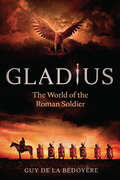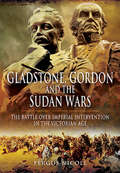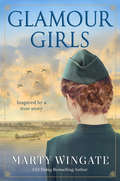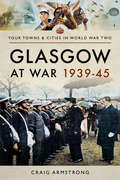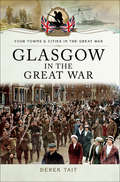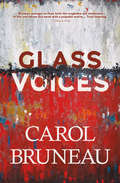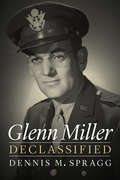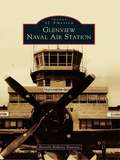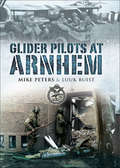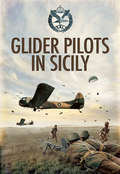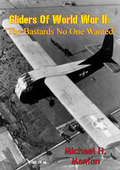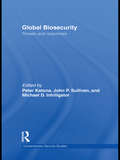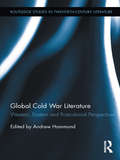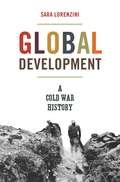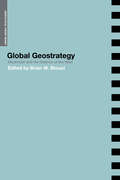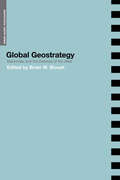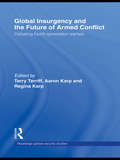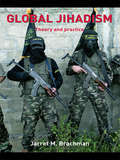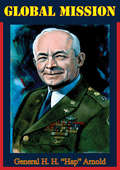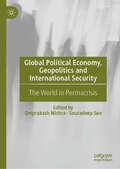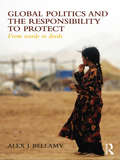- Table View
- List View
Gladius: The World of the Roman Soldier
by Guy de la BédoyèreThis &“encyclopedic [volume] collects pretty much every fact known about what it was like to be in the military arm of the Roman Empire" (The New York Times Book Review). The Roman army was the greatest fighting machine in the ancient world. It was also the single largest organization in Western antiquity, taking in members from all classes, from senators to freed slaves. The Roman Empire depended on its army not just to win wars, defend its frontiers, and control the seas, but to act as the very engine of the state. In Gladius—the Latin word for sword—Guy De la Bédoyère reveals what it meant to be a soldier in the army that made the empire. Surveying numerous aspects of Roman military life between 264 BCE and 337 CE, De la Bédoyère draws not only on the words of famed Roman historians, but also those of the soldiers themselves, as recorded in their religious dedications, tombstones, and even private letters and graffiti. He vividly recreates their everyday lives, whether in a bleak frontier garrison in Britain or North Africa, guarding the emperor in Rome, fighting on foreign battlefields, mutinying over pay, marching in triumph, throwing their weight around on city streets, or enjoying honorable retirement. By illuminating the history of one organization that reflected all corners of the Roman world, Gladius gives us a portrait of an ancient society that is unprecedented in both its broad sweep and gritty intimacy.
Gladstone, Gordon and the Sudan Wars: The Battle over Imperial Invention in the Victorian Age
by Fergus NicollGeneral Gordons death in Khartoum on 26 January 1885 and the fall of the besieged city to the forces of the Mahdi was a crucial episode in British imperial history. It was deeply controversial at the time, and it still is today. Gordon has routinely been depicted as the hero of the story, in contrast to Prime Minister Gladstone who is often portrayed as the villain of the piece, responsible for a policy of drift in Sudan.Fergus Nicolls radical reappraisal, which is based on eyewitness accounts and previously unpublished archive material, refutes the conventional image of both men. Presenting an inside view of Gladstones thinking and decision-making, Nicoll gives the prime minister credit for his steadfast insistence that Britain should have minimal engagement in and zero responsibility for Sudan. Gordon, who succumbed to a lasting mania that skewed his decision-making and undermined his military capacity, is cast in a more sceptical light. This fascinating insight into British policy in Africa exposes the inner workings of government, the influence of the press and public opinion and the power of a book to change a government.Each stage in the rapid sequence of events is reconsidered Gladstones steely determination to avoid involvement, Gordons partial evacuation of Khartoum, the siege, the despatch of the relief expedition that arrived too late, the abandonment of Sudan, and the subsequent political battle over responsibility. The personal cost to both men was great: Gordon lost his life and Gladstone saw his reputation gravely tarnished.
Glamour Girls: A Novel
by Marty WingateUSA Today bestselling author Marty Wingate's historical debut is "like reading a personal diary of the brave women who were unsung heroes of WWII," (Rhys Bowen, Royal Spyness mysteries) and will delight readers of Kelly Rimmer's The Things We Cannot Say and Noelle Salazar's The Flight Girls.During World War II, farmer's daughter Rosalie Wright becomes a pilot assisting the RAF. But will a romantic rivalry send her aerial dreams plummeting to earth?Ever since she was 10 years old, Rosalie Wright's eyes have been on the skies. But at the age of 18, on the verge of earning her pilot's license, the English farmer's daughter watches her dreams of becoming an aviatrix fly away without her. Britain's entry into World War II brings civilian aviation to a standstill. Then, Rosalie's father dies, leaving her, her mother, and her brothers to run the farm.Everything changes when she learns that the Air Transport Authority is recruiting women pilots to ferry warplanes across Britain to RAF bases. Despite her mother's objections, Rosalie cannot resist the call of her country--and the lure of the skies. During her training on Gipsy Moth aircraft, Rosalie forms a fast friendship with fellow flyer Caroline Andrews. Her trusty Ferry Pilots Notebook by her side, Rosalie delivers to five airfields in a day--while fighting an endless battle against skeptical male pilots and ground crews.She would much rather spend her time on the wing than on the arm of any man...until she meets gruff pilot Snug Durrant and RAF squadron leader Alan Chersey. Snug is a cynical, wisecracking playboy, and Alan is every WAAF's heartthrob...and Rosalie catches both their eyes. As the war drags on, and casualties mount, will love and tragedy send Rosalie's exhilarating airborne life crashing to the ground?
Glasgow at War, 1939–45 (Your Towns & Cities in World War Two)
by Craig ArmstrongAn in-depth look at how Scotland&’s largest city and its residents were affected by the Second World War, with photos included. Scotland was of grave strategic importance during World War II because of its geographical position, and Glasgow was the location of a significant number of important military and civil organizations as well as housing industry vital to the national war effort. As a result, Glasgow attracted enemy attention on many occasions—with the city and its hinterland being heavily raided by the Luftwaffe. These included the infamous raid on Clydebank in March 1941, which killed over five hundred civilians and left only seven houses undamaged in the town. Although Glasgow&’s shipyards, munitions factories, and other industries were all vital, so too was the location of the city itself. The River Clyde was the end point for many Atlantic convoys bringing precious food, material, and men to the war-struck British Isles, and the city was thus a vital link in the nation&’s war effort. No member of the population of Glasgow escaped the war. Huge numbers of men and women from the area came forward for service in the military or in roles involving the Home Guard, ARP services, nursing, and vital war industries. Residents struggled to maintain a household under strict rationing and the stresses of wartime life, and children were evacuated from the city to rural areas to escape the bombing campaigns. Glasgow was also home to a sizable Italian community, which was badly affected by internment and tight restrictions on movement and civil rights. The Italian community was also subjected to violent attacks when rioting mobs attacked Italian-owned business throughout the city. Glasgow at War 1939-1945 paints a portrait of a city fighting to survive, and poignantly commemorates the efforts and achievements of workers, fighters, and families divided.
Glasgow in the Great War
by Derek TaitWhen news of the war broke out in 1914, nothing could prepare the citizens of Glasgow for the changes that would envelop their city over the next four years. The story of Glasgow in the Great War is both an interesting and intriguing one. This book covers this historic citys involvement from the commencement of the Great War in July 1914, to the Armistice in November 1918, describing in great detail what happened to the city and its people, including their everyday lives, entertainment, spies and the internment of aliens living within the city.Glasgow played a key role in the deployment of troops to Northern Europe as well as supplying vital munitions. Local men responded keenly to recruitment drives and thousands of soldiers were billeted in the city before being sent off to fight the enemy overseas. The city also played a vital role in caring for the many wounded soldiers who returned home from the Front.The effect of the war on Glasgow was great. By the end of the conflict, there wasn't a family in Glasgow who hadn't lost a son, father, nephew, uncle or brother. There were tremendous celebrations in the streets as the end of the war was announced but the effects of the war lasted for years to come.Glasgow in the Great War features many forgotten news stories of the day and includes a considerable collection of rare photographs last seen in newspapers nearly 100 years ago.
Glass Voices: 10th Anniversary Edition
by Carol BruneauSurviving the 1917 Halifax Explosion leaves a grieving Nova Scotia couple on a long and difficult road to redemption in this &“textured and rich&” novel (Quill & Quire). Though they survived the Halifax Explosion of 1917, Lucy Caines and her wayward husband, Harry, lost everything in the day&’s terrible events—including their infant daughter. Determined to make peace with their grief and salvage what&’s left of their lives, they begin to rebuild on the rustic shores of Halifax&’s Northwest Arm. But coping isn&’t easy, and each descends into isolation and denial: Lucy through guilt and reticence, and Harry through drinking and gambling. Despite the birth of a treasured son, the couple faces a future clouded by fear and apprehension. Then, fifty-two years after the catastrophe, yet another calamity strikes. Now Lucy must confront the miracle of their survival, reexamine the past, and struggle to become the author of her own happiness.
Gleam and Glow
by Eve BuntingIt’s too dangerous to stay any longer--the war is coming closer. Viktor, little Marina, and Mama must pack what they can carry and flee their home. As they trudge beside the other refugees, Viktor worries about what lies ahead, and what he’s left behind--his room, his books, the fish Marina loves so much. Even worse, his papa is off fighting with the Liberation Army and doesn’t know they’ve left home. How will Papa ever find them now? Inspired by real events, master storyteller Eve Bunting recounts the harrowing yet hopeful story of a family, a war--and a dazzling discovery.
Glenn Miller Declassified
by Dennis M. SpraggOn December 15, 1944, Maj. Alton Glenn Miller, commanding officer of the Army Air Force Band (Special), boarded a plane in England bound for France with Lt. Col. Norman Francis Baessell. Somewhere over the English Channel the plane vanished. No trace of the aircraft or its occupants has ever been found. To this day Miller, Baessell, and the pilot, John Robert Stuart Morgan, are classified as missing in action. Weaving together cultural and military history, Glenn Miller Declassified tells the story of the musical legend Miller and his military career as commanding officer of the Army Air Force Band during World War II. After a brief assignment to the Army Specialist Corps, Miller was assigned to the Army Air Forces Training Command and soon thereafter to Supreme Headquarters, Allied Expeditionary Force, in the UK. Later that year Miller and his band were to be transferred to Paris to expand the Allied Expeditionary Forces Programme, but Miller never made it. Miller’s disappearance resulted in numerous conspiracy theories, especially since much of the information surrounding his military service had been classified, restricted, or, in some cases, lost. Dennis M. Spragg has gained unprecedented access to the Miller family archives as well as military and government documents to lay such theories to rest and to demonstrate the lasting legacy and importance of Miller’s life, career, and service to his country.
Glenview Naval Air Station (Images of America)
by Beverly Roberts DawsonIn 1923--just 20 years after the Wright brothers' first flight at Kitty Hawk--a Naval Reserve aviation training program was established at Great Lakes Naval Training Center. Originally, sea planes and a few small land-based planes were used for primary flight instruction. With the development of heavier, faster military aircraft, the Great Lakes facility became inadequate. Under Rear Adm. John Downes, commandant of the 9th Naval District, the search for a suitable new location was undertaken. Curtiss-Reynolds-Wright Airfield was deemed ideal for relocation of the aviation training program. From humble beginnings as Naval Reserve Aviation Base Chicago, Naval Air Station Glenview (the official U.S. Navy designation) went on to play a vital and unique role during World War II. Until closure in 1995, the base was home to thousands of Navy and Marine Reserve pilots, aircrews, and support personnel--proudly known as weekend warriors."
Glider Pilots at Arnhem
by Mike Peters Luuk BuistThe fierce struggle between the British 1st Airborne Division and the superior German forces in and around Arnhem is well documented. This book tells of the role played in the battle for Oosterbeek and the bridge at Arnhem itself by the men of the Glider Pilot Regiment (GPR). These men were already experienced soldiers who volunteered to join the airborne forces and take the fight to the Germans in a totally new regiment.The men of the GPR were predominantly SNCOs trained to fly wooden assault gliders into occupied territory. Once on the ground they were expected to go into battle with the troops they had delivered onto the Landing Zone. During the Arnhem operation they were involved in the initial defense of the LZs, before fighting house to house leading mixed groups of infantrymen, engineers and medics. In so doing they suffered extensive losses from which the Regiment never fully recovered. This book tells their story in their own words from the moment they landed on Dutch soil through the fierce fighting all around the ever shrinking perimeter until the survivors of the GPR proudly marked the route out for the battered survivors of 1st Airborne Division as they escaped over the Rhine.
Glider Pilots in Sicily
by Mike PetersThe British Airborne landings on Sicily are the least known and, without doubt, the most fraught with political and technical strife. Newly formed Air landing troops were delivered into battle in gliders they knew little about. The men of the Glider Pilot Regiment (GPR) had self-assembled the gliders while living in the empty packing cases. They accomplished this complex and technically challenged task while living on fly ridden, dusty North African airfields. After only a few hours of conversion training they took off for a night flight across the Mediterranean Sea that was to end in near-catastrophe.With over three hundred soldiers drowned off Sicily that night in July 1943, the first major operation attempted by the British using gliders almost ended in total disaster. In fact a few Airborne troops reached dry land and attacked their objectives. Shining examples of collective and individual acts of courage rocked the Italian and German defenders. This book tells the controversial story of that first mass glider operation and the men who proved the GPR motto Nothing is Impossible.This is the first account of the Sicily air landing operation.
Gliders of World War II: ‘The Bastards No One Wanted’
by Major Michael H. ManionThis study examines the role of combat gliders in Germany, the United Kingdom, and the United States during World War II (WWII). This thesis compares and contrasts each country with respect to pre-WWII glider experience, glider and airborne doctrine, glider pilot training, and glider production while outlining each country's major glider operations. The author then compares the glider operations in the China-Burma-India Theater to the operations in Europe to describe the unique challenges based on the terrain and mission. Next, this thesis presents an analysis of the glider's precipitous decline following WWII. The study concludes with recommendations for glider operations in the future based on the experiences of the past.
Glimmers of Change (The Bregdan Chronicles Ser. #7)
by Ginny DyeGlimmers of Change continues the sweeping historical saga that encompasses the first full year of the American Reconstruction. However, has the Civil War really ended? As far as the characters are concerned, Carrie and Janie are living their dream in Philadelphia, but what price will they pay when cholera sweeps through America once again? Robert searches for peace on the plantation, but forces are in place that are determined to deny it. Moses and Rose are driven by forces beyond their control to become leaders in the midst of a violent racial revolution. Jeremy discovers love, but will the reality of his heritage make it impossible, and will he survive the forces determined to destroy the factory? Finally, will Matthew free his heart and find love?
Global Biosecurity: Threats and Responses (Contemporary Security Studies)
by Peter KatonaThis book explores a range of biohealth and biosecurity threats, places them in context, and offers responses and solutions from global and local, networked and pyramidal, as well as specialized and interdisciplinary perspectives. Specifically covering bioterrorism, emerging infectious diseases, pandemic disease preparedness and remediation, agroterroism, food safety, and environmental issues, the contributors demonstrate that to counter terrorism of any kind, a global, networked, and multidisciplinary approach is essential. To be successful in biosecurity, this book argues it is necessary to extend partnerships, cooperation, and co-ordination between public health, clinical medicine, private business, law enforcement and other agencies locally, nationally and internationally. Internationally, a clear understanding is needed of what has happened in past epidemics and what was accomplished in past bioprograms (in Britain, South Africa, Russia, for example). This book also assesses how, with the right technology and motivation, both a state and a non-state actor could initiate an extremely credible biothreat to security at both local and national levels. This book will be of much interest to students, researchers and practitioners of security studies, public health, public policy and IR in general. Peter Katona is Associate Professor of Clinical Medicine at the David Geffen School of Medicine at UCLA in Infectious Diseases. He is co-founder of Biological Threat Mitigation, a bioterror consulting firm. John P. Sullivan is a lieutenant with the Los Angeles Sheriff’s Department. He is also a researcher focusing on terrorism, conflict disaster, intelligence studies, and urban operations. He is co-founder of the Los Angeles Terrorism Early Warning (TEW) Group. Michael D. Intriligator is Professor of Economics at the University of California, Los Angeles (UCLA). He is also Professor of Political Science, Professor of Public Policy in the School of Public Policy and Social Research, and Co-Director of the Jacob Marschak Interdisciplinary Colloquium on Mathematics in the Behavioral Sciences, all at UCLA.
Global Burden of Armed Violence 2015
by GenevaThe 2015 edition of the Global Burden of Armed Violence provides a wealth of data relevant to security and the post-2015 sustainable development framework. It estimates that 508,000 people died violently - in both conflict and non-conflict settings - every year in 2007–12, down from 526,000 in 2004–09. This trend is visible in non-conflict settings, where the proportion of women and girls is also slightly reduced, from 17 to 16 per cent. Yet, the number of direct conflict deaths is on the rise: from 55,000 to 70,000 per year over the same periods. Firearms are used in close to half of all homicides committed and in almost one-third of direct conflict deaths. Nearly USD 2 trillion in global homicide-related economic losses could have been saved if the homicide rate in 2000–10 had been reduced to the lowest practically attainable levels - between 2 and 3 deaths per 100,000 population.
Global Cold War Literature: Western, Eastern and Postcolonial Perspectives (Routledge Studies in Twentieth-Century Literature #Vol. 3)
by Andrew HammondIn countries worldwide, the Cold War dominated politics, society and culture during the second half of the twentieth century. Global Cold War Literatures offers a unique look at the multiple ways in which writers from Asia, Africa, Europe and North and South America addressed the military conflicts, revolutions, propaganda wars and ideological debates of the era. While including essays on western European and North American literature, the volume views First World writing, not as central to the period, but as part of an international discussion of Cold War realities in which the most interesting contributions often came from marginal or subordinate cultures. To this end, there is an emphasis on the literatures of the Second and Third Worlds, including essays on Latin American poetry, Soviet travel writing, Chinese autobiography, African theatre, North Korean literature, Cuban and eastern European fiction, and Middle Eastern fiction and poetry. With the post-Cold War era still in a condition of emergence, it is essential that we look back to the 1945-89 period to understand the political and cultural forces that shaped the modern world. The volume’s analysis of those forces and its focus on many of the ‘hot spots’ – Afghanistan, Iran, North Korea – that define the contemporary ‘war on terror’, make this an essential resources for those working in Postcolonial, American and English Literatures, as well as in History, Comparative Literature, European Studies and Cultural Studies. Global Cold War Literatures is a suitable companion volume to Hammond's Cold War Literature: Writing the Global Conflict, also available from Routledge.
Global Development: A Cold War History (America in the World #38)
by Sara LorenziniIn the Cold War, "development" was a catchphrase that came to signify progress, modernity, and economic growth. Development aid was closely aligned with the security concerns of the great powers, for whom infrastructure and development projects were ideological tools for conquering hearts and minds around the globe, from Europe and Africa to Asia and Latin America. In this sweeping and incisive book, Sara Lorenzini provides a global history of development, drawing on a wealth of archival evidence to offer a panoramic and multifaceted portrait of a Cold War phenomenon that transformed the modern world.Taking readers from the aftermath of the Second World War to the tearing down of the Berlin Wall, Lorenzini shows how development projects altered local realities, transnational interactions, and even ideas about development itself. She shines new light on the international organizations behind these projects—examining their strategies and priorities and assessing the actual results on the ground—and she also gives voice to the recipients of development aid. Lorenzini shows how the Cold War shaped the global ambitions of development on both sides of the Iron Curtain, and how international organizations promoted an unrealistically harmonious vision of development that did not reflect local and international differences.An unparalleled journey into the political, intellectual, and economic history of the twentieth century, this book presents a global perspective on Cold War development, demonstrating how its impacts are still being felt today.
Global Geostrategy: Mackinder and the Defence of the West
by Brian W. BlouetThis is a new examination of Halford Mackinder’s seminal global geostrategic work, from the perspective of geography, diplomatic history, political science, international relations, imperial history, and the space age.Mackinder was a man ahead of his time. He foresaw many of the key strategic issues that came to dominate the twentieth century. Until the disintegration of the Soviet Union, western defence strategists feared that one power, or alliance, might come to dominate Eurasia. Admiral Mahan discussed this issue in The Problem of Asia (1900) but Mackinder made the most authoritative statement in "The Geographical Pivot of History" (1904). He argued that in the "closed Heart-Land of Euroasia" was a strategically placed region, with great resources, that if controlled by one force could be the basis of a World Empire. James Kurth, in Foreign Affairs, has commented that it has taken two World Wars and the Cold War to prevent Mackinder’s prophecy becoming reality. In World War I and World War II Germany achieved huge territorial gains at the expense of the Russian empire and the Soviet Union. In the former conflict the Russian empire was defeated by Germany but the western powers insisted that the territorial gains made by Germany, at the treaty of Brest-Litovsk, be given up. In World War II Britain and the US gave material support to Stalin’s totalitarian regime to prevent Nazi Germany gaining control of the territory and resources that might have been a basis for world domination. The west, highly conscious of Mackinder’s dictum (1919) that "Who rules East Europe commands the Heartland," quickly adopted policies to contain the Soviet Union. History has therefore proved Mackinder’s work to be of vital importance to generations of strategic thinking and he remains a key influence in the new millennium.This book will be of great interest to all students and scholars of strategic studies and military history and of geopolitics in particular.
Global Geostrategy: Mackinder and the Defence of the West (Geopolitical Theory)
by Brian W. BlouetThis is a new examination of Halford Mackinder’s seminal global geostrategic work, from the perspective of geography, diplomatic history, political science, international relations, imperial history, and the space age. Mackinder was a man ahead of his time. He foresaw many of the key strategic issues that came to dominate the twentieth century. Until the disintegration of the Soviet Union, western defence strategists feared that one power, or alliance, might come to dominate Eurasia. Admiral Mahan discussed this issue in The Problem of Asia (1900) but Mackinder made the most authoritative statement in "The Geographical Pivot of History" (1904). He argued that in the "closed Heart-Land of Euroasia" was a strategically placed region, with great resources, that if controlled by one force could be the basis of a World Empire. James Kurth, in Foreign Affairs, has commented that it has taken two World Wars and the Cold War to prevent Mackinder’s prophecy becoming reality. In World War I and World War II Germany achieved huge territorial gains at the expense of the Russian empire and the Soviet Union. In the former conflict the Russian empire was defeated by Germany but the western powers insisted that the territorial gains made by Germany, at the treaty of Brest-Litovsk, be given up. In World War II Britain and the US gave material support to Stalin’s totalitarian regime to prevent Nazi Germany gaining control of the territory and resources that might have been a basis for world domination. The west, highly conscious of Mackinder’s dictum (1919) that "Who rules East Europe commands the Heartland," quickly adopted policies to contain the Soviet Union. History has therefore proved Mackinder’s work to be of vital importance to generations of strategic thinking and he remains a key influence in the new millennium. This book will be of great interest to all students and scholars of strategic studies and military history and of geopolitics in particular.
Global Insurgency and the Future of Armed Conflict: Debating Fourth-Generation Warfare (Routledge Global Security Studies)
by Terry TerriffThis volume covers a timely debate in contemporary security studies: can armed forces adjust to the rising challenge of insurgency and terrorism, the greatest transformation in warfare since the birth of the international system? Containing essays by leading international security scholars and military professionals, it explores the Fourth-Generation Warfare thesis and its implications for security planning in the twenty-first century. No longer confined to the fringes of armed conflict, guerrilla warfare and terrorism increasingly dominate world-wide military planning. For the first time since the Vietnam War ended, the problems of insurgency have leapt to the top of the international security agenda and virtually all countries are struggling to protect themselves against terrorist threats. Coalition forces in Afghanistan and Iraq are bogged down by an insurgency, and are being forced to rely on old warfare tactics rather than modern technologies to destroy their adversaries. These theorists argue that irregular warfare—insurgencies and terrorism—has evolved over time and become progressively more sophisticated and difficult to defeat as it is not centred on high technology and state of the art weaponry. Global Insurgency and the Future of Armed Conflict will be of interest to students of international security, strategic studies and terrorism studies.
Global Jihadism: Theory and Practice (Political Violence)
by Jarret M. BrachmanGlobal Jihadism exposes the core doctrine and strategy of today’s global Jihadist movement. The first half of the book explores the ideas upon which groups such as Al Qaeda are built, including the concepts of Jihad, al-Wala wal-Bara, Takfir and Tawhid. Jarret Brachman exposes a genre of Jihadist strategic scholarship that has been virtually ignored in the West and helps to situate it within the broader Salafist religious movement. The second half explores the thinking and activities of Al Qaeda’s propaganda machine, explaining its intricacies and idiosyncrasies. It includes case studies on the rise and fall of global Jihadist terrorism in Saudi Arabia post-9/11, and highlights the explosive results of bringing theory to bear on practice in the United Kingdom over the past twenty years. The book concludes by providing innovative strategies for combating the global Jihadist ideology.
Global Maritime Military Strategy, 1980–2023
by Keitaro UshirogataThis open access book is an ambitious study about how to use comparative methods to analyze contemporary military strategy in the maritime domain. Based on the three strategic concepts of area denial, sea control and power projection, this book analyzes the intensive conventional capabilities of six major powers’ military strategies. These include the United States, the United Kingdom and Japan, the so-called ‘sea powers,’ and Russia, China and India, which are usually recognized as ‘land-powers.’Through the analysis, this book aims to accomplish the following three main objectives: 1. To reconsider the basic concepts of maritime military strategic studies, which have not changed for almost one hundred years, and to propose a new analytical framework based on the following three elements—as well as verifying the appropriateness of this framework. a. The capability with which a country can deny military threat against its territory through the maritime domain within the geographic theater, i.e., roughly one thousand to two thousand kilometers from its coastline (area denial). b. The capability with which a country can obtain military superiority or disrupt an adversary’s military superiority in the open ocean (sea control). c. The capability with which a country can project military power from the maritime domain to other countries’ territories, accomplishing military strategic objectives (power projection). 2. To verify the six major powers’ long-term military strategic objectives, for example, whether the country aims to enhance its power in the maritime domain, or to project its military power to the other countries/areas beyond the maritime domain; to do this by analyzing each country’s force building directions. In addition, this book assesses each country’s capability for high-intensive conflict and unravels each security/military strategic objectives.3. By examining the strategic objectives of major powers, this book may contribute to establishing Japan’s future defense strategy.
Global Mission
by General H. H. “Hap” Arnold"Hap" Arnold, Commander-in-Chief of the greatest Air Force the world has ever seen, tells the story of his life, of how our air power was developed and of the great decisions and operations of World War II."(Hap Arnold was) a dedicated officer in a specialized field,...and at the same time, a human being, a warm-hearted, loyal, mercurial, flamboyantly belligerent fellow who didn't care who he took on in battle."--Robert A. Lovett
Global Political Economy, Geopolitics and International Security: The World in Permacrisis
by Omprakash Mishra Souradeep SenThe volume delves into the intricate web of contemporary permacrisis rooted in the strategic imperatives of nation-states. Through a historical lens, it navigates the evolving landscape of international politics, tracing the transition of power dynamics from purely military to a fusion of economic and military prowess. The contributions in the volume argue that this shift has redefined the traditional balance of power, with economic instruments emerging as potent tools for geopolitical manoeuvring. Examining the interplay of geopolitical, geoeconomic, and security imperatives, it scrutinises the complex relationships that often perpetuate crises instead of global stability. It sheds light on the unprecedented hybridity of modern warfare, where military and economic dimensions intertwine, exemplified by the ongoing tensions between the liberal international order on the one hand, and Russia and China on the other. Recognising this complexity, the volume raises concerns about the uneven capacity of states to navigate these imperatives. Beneficial for specialists in International Relations and Strategic Studies, policymakers, security experts, scholars, and postgraduate students, this comprehensive volume offers insights into the intricate dynamics of geopolitics, political economy, and security issues of our time.
Global Politics and the Responsibility to Protect: From Words to Deeds (Global Politics and the Responsibility to Protect)
by Alex J. BellamyThis book provides an in-depth introduction to, and analysis of, the issues relating to the implementation of the recent Responsibility to Protect principle in international relations The Responsibility to Protect (RtoP) has come a long way in a short space of time. It was endorsed by the General Assembly of the UN in 2005, and unanimously reaffirmed by the Security Council in 2006 (Resolution 1674) and 2009 (Resolution 1894). UN Secretary-General Ban Ki-moon has identified the challenge of implementing RtoP as one of the cornerstones of his Secretary-Generalship. The principle has also become part of the working language of international engagement with humanitarian crises and has been debated in relation to almost every recent international crisis – including Sudan, Sri Lanka, Myanmar, Georgia, the Democratic Republic of Congo, Darfur and Somalia. Concentrating mainly on implementation challenges including the prevention of genocide and mass atrocities, strengthening the UN’s capacity to respond, and the role of regional organizations, this book introducing readers to contemporary debates on R2P and provides the first book-length analysis of the implementation agenda. The book will be of great interest to students of the responsibility to protect, humanitarian intervention, human rights, foreign policy, security studies and IR and politics in general.
